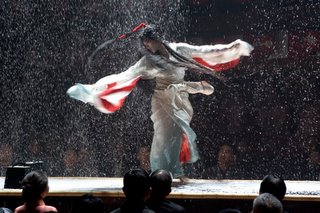 Memoirs Of A Geisha, the picture-book new film from Chicago director Rob Marshall doesn't pretend to be a complicated drama, but the source novel, Arthur Golden's best-selling 1997 potboiler, never had pretentions of depth either. Instead, both book and movie provide a lush, immaculately detailed and visually absorbing portrayal of a peculiarly Japanese world, that of the special class of paid female companions, artists, musicians and, to be blunt about it, chatteled sex workers: the geisha.
Memoirs Of A Geisha, the picture-book new film from Chicago director Rob Marshall doesn't pretend to be a complicated drama, but the source novel, Arthur Golden's best-selling 1997 potboiler, never had pretentions of depth either. Instead, both book and movie provide a lush, immaculately detailed and visually absorbing portrayal of a peculiarly Japanese world, that of the special class of paid female companions, artists, musicians and, to be blunt about it, chatteled sex workers: the geisha.
The film opens with an almost silent sequence that highlights the considerable talents of young actress Suzuka Ohgo playing the frightened young Chiyo, taken from her impoverished family in 1929 and sold to a renowned geisha house in Kyoto. Here she is subjected to cruel treatment from the owner Mother (Kaori Momoi), who works the little girl to the bone, with Chiyo’s slavery made even more unbearable by the malignant attentions of Hatsumomo (Gong Li from Raise the Red Lantern). The reigning queen of the geisha house, Hatsumomo realises the threat the newcomer represents, not to her present, but to her inheritance, and cruelly engineers her isolation, especially from her only friend, Pumpkin (Youki Kudoh). She frames Chiyo for a minor crime, which leads to her being sold to Mameha (Michelle Yeoh, also from Crouching Tiger, Hidden Dragon), a beautiful geisha in her late thirties who is the companion of the Baron (Cary-Hiroyuki Tagawa) and his friend, the wealthy Chairman (Ken Watanabe from The Last Samurai). With Mameha’s careful tutelage, the shy and withdrawn Chiyo becomes the radiant geisha Sayuri, the talk of the town and a famed entertainer. The girls have been carefully drilled to realise that love has no role in their new world; that these men are clients, not potential husbands. The distinction between these women and prostitutes, and the geisha and a wife is made clear, with politically motivated flattery replacing the honesty of romance. Nevertheless, Sayuri falls in love with the Chairman, always keeping his dropped handkerchief and a newspaper photograph in the folds of her kimono.
Regardless of how she delivers her dialogue, Ziyi Zhang (House Of Flying Daggers) has the face of an angel, sometimes blank and serene but always filled with subtleties and tiny human gestures that add tremendous soul to her performance. For his part, Watanabe’s Chairman, representing an idealised concept of love for the innocent Sayuri (his dropped handkerchief becomes her prized possession) plays a storybook romantic ideal, capable, brave and kind. But their gradual coming together takes a back seat to Sayuri’s own coming of age, which, once achieved, leaves the remainder of the broadly drawn, essentially formulaic Cinderella melodrama with nowhere to go. Still, it is a lovely thing to look at, and sometimes that's enough.
In one way, the painstaking approach to the first two-thirds of the film, the precise and painstaking recreation of this complicated world, is to be applauded; it’s slow unravelling setting a totally immersive, captivating tone. However, the film as a whole never recovers from the brutal intrusion of the Second World War and the subsequent occupation of Japan by the beer-swilling, skirt-chasing Americans. A subplot running through the film that highlights how these young women were cast against each other as rivals falls flat in it’s clumsy resolution, with the viewers attention taken more with where they are (and how gorgeous it all looks) rather than what they are saying to one another or what it means to Sayuri’s desperate love. Marshall has conjured up a lost world with considerable fluency, but the magic of the film is in it's recreations, almost alien in their exoticism, and not its uninvolving emotions.







3 comments:
Couldn't bear the first 10 minutes of the self-dubbing asian cast myself - credit to Marshall that it can be gotten over. Ending bit drab though - much like the book. I think if the bulk of a book is decent and it's fiction you're entitled to jettison a shitty conclusion. (On a complete sidebar John, your sentences are reassuringly long - I've been writing reviews for SBP past few weeks and looking back at first drafts. You could fit a novel between the periods. I thought it was a weakness...
I agree with your implicit evaluation: great cast; beautiful photography; flat and non-involving story; annoying perfect English (with just an oriental accent) on Japanese mouths in a Japanese setting.
Just went to see this last night, and although pretty to watch I found the film itself ever so boring.
Post a Comment